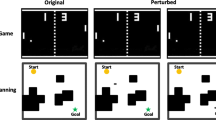Abstract
Upcoming technological innovations and findings are immense in the field of intelligent transport systems (ITS). Cyber-physical systems (CPSs) are complex systems that integrate communication, control, and computing technology. CPSs are widely used today in intelligent transportation. For every development of a new system, there is a parallel offender who initiates the attack to destroy the root of the system developed. The attack category is infinite in such developing technology. In this paper, we have focused on preserving the security of ITS from cyber-physical systems perceptive, and various vulnerabilities, attacks, and countermeasures against ITS. Reinforcement learning is the latest buzzword in which an agent can understand and explain the environment, perform an action, and learn through trial and error. The paper also explains how reinforcement learning helps ITS in terms of security.





Similar content being viewed by others
Data availability
Not applicable.
References
Belhadi A, Djenouri Y, Srivastava G, Lin JCW. SS-ITS: secure scalable intelligent transportation systems. J Supercomput. 2021;77(7):7253–69. https://doi.org/10.1007/s11227-020-03582-7.
Pham M, Xiong K. A survey on security attacks and defense techniques for connected and autonomous vehicles. Comp Sec. 2021. https://doi.org/10.1016/j.cose.2021.102269.
El-Rewini Z, Sadatsharan K, Selvaraj DF, Plathottam SJ, Ranganathan P. Cybersecurity challenges in vehicular communications. Vehicular Communicat. 2020. https://doi.org/10.1016/j.vehcom.2019.100214.
Rasheed I, Hu F, Zhang L. Deep reinforcement learning approach for autonomous vehicle systems for maintaining security and safety using LSTM-GAN. Vehicular Communicat. 2020. https://doi.org/10.1016/j.vehcom.2020.100266.
Sun X, Yu FR, Zhang P. A survey on cyber-security of connected and autonomous vehicles (CAVs). IEEE Trans Intell Transp Syst. 2022;23(7):6240–59. https://doi.org/10.1109/TITS.2021.3085297.
El-Rewini Z, Sadatsharan K, Sugunaraj N, Selvaraj DF, Plathottam SJ, Ranganathan P. Cybersecurity attacks in vehicular sensors. IEEE Sens J. 2020;20(22):13752–67. https://doi.org/10.1109/JSEN.2020.3004275.
Tlili F, Fourati LC, Ayed S, Ouni B. Investigation on vulnerabilities, threats and attacks prohibiting UAVs charging and depleting UAVs batteries: assessments & countermeasures. Ad Hoc Net. 2022. https://doi.org/10.1016/j.adhoc.2022.102805.
Asghar Khan M, et al. A provable and privacy-preserving authentication scheme for UAV-enabled intelligent transportation systems. IEEE Trans Industr Inform. 2022;18(5):3416–25. https://doi.org/10.1109/TII.2021.3101651.
Kong PY. A survey of cyberattack countermeasures for unmanned aerial vehicles. IEEE Access. 2021;9:148244–63. https://doi.org/10.1109/ACCESS.2021.3124996.
Chowdhury A, Karmakar G, Kamruzzaman J, Islam S. Trustworthiness of self-driving vehicles for intelligent transportation systems in industry applications. IEEE Trans Industr Inform. 2021;17(2):961–70. https://doi.org/10.1109/TII.2020.2987431.
Fei F, Tu Z, Xu D, Deng X (2020) Learn-to-Recover: Retrofitting UAVs with Reinforcement Learning-Assisted Flight Control Under Cyber-Physical Attacks, Learn-to-Recover: Retrofitting UAVs with Reinforcement Learning-Assisted Flight Control Under Cyber-Physical Attacks.
Guo RX, Tian JW, Wang BH, te Shang F (2020) “Cyber-Physical Attack Threats Analysis for UAVs from CPS Perspective.” In: Proceedings—2020 International Conference on Computer Engineering and Application, ICCEA 2020, p. 259–263. doi: https://doi.org/10.1109/ICCEA50009.2020.00063.
Cao L, Jiang X, Zhao Y, Wang S, You D, Xu X. A survey of network attacks on cyber-physical systems. IEEE Access. 2020;8:44219–27. https://doi.org/10.1109/ACCESS.2020.2977423.
Chowdhury A, Karmakar G, Kamruzzaman J, Jolfaei A, Das R. Attacks on self-driving cars and their countermeasures: a survey. IEEE Access. 2020;8:207308–42. https://doi.org/10.1109/ACCESS.2020.3037705.
Sakthivel S. UBP-trust: user behavioral pattern based secure trust model for mitigating denial of service attacks in software as a service (SaaS) cloud environment. J Computat Theoret Nanosci. 2016;13(10):7649.
Ribouh S, Phan K, Malawade AV, Elhillali Y, Rivenq A, Al Faruque MA. Channel state information-based cryptographic key generation for intelligent transportation systems. IEEE Transact Intell Transportat Sys. 2021;22(12):7496–507. https://doi.org/10.1109/TITS.2020.3003577.
Hammar K, Stadler R (2020) “Finding Effective Security Strategies through Reinforcement Learning and Self-Play,” In: 2020 16th International Conference on Network and Service Management (CNSM), doi: https://doi.org/10.23919/CNSM50824.2020.9269092.
Zhang J, Pan L, Han QL, Chen C, Wen S, Xiang Y. Deep learning based attack detection for cyber-physical system cybersecurity: a survey. IEEE/CAA Journal of Automatica Sinica. 2022;9(3):377–91. https://doi.org/10.1109/JAS.2021.1004261.
Ahmed Jamal A, Mustafa Majid A-A, Konev A, Kosachenko T, Shelupanov A. A review on security analysis of cyber physical systems using machine learning. Mater Today Proc. 2021. https://doi.org/10.1016/j.matpr.2021.06.320.
Cai X, Han K, Li Y, Wang H, Zhang J, Zhang Y (2020) “Research on Security Estimation and Control of Cyber-Physical System,” doi: https://doi.org/10.1109/IPCCC50635.2020.9391573.
Karthick K, et al. Iterative dichotomiser posteriori method-based service attack detection in cloud computing. Comput Syst Sci Eng. 2023;44(2):1099–107.
Dong C, Wang H, Ni D, Liu Y, Chen Q. Impact evaluation of cyber-attacks on traffic flow of connected and automated vehicles. IEEE Access. 2020;8:86824–35. https://doi.org/10.1109/ACCESS.2020.2993254.
Kiran BR, et al. Deep reinforcement learning for autonomous driving: a survey. IEEE Trans Intell Transp Syst. 2022;23(6):4909–26. https://doi.org/10.1109/TITS.2021.3054625.
Haydari A, Yilmaz Y. Deep reinforcement learning for intelligent transportation systems: a survey. IEEE Trans Intell Transp Syst. 2022;23(1):11–32. https://doi.org/10.1109/TITS.2020.3008612.
Bhattacharya A, Ramachandran T, Banik S, Dowling CP, Bopardikar SD (2020) “Automated Adversary Emulation for Cyber-Physical Systems via Reinforcement Learning,” doi: https://doi.org/10.1109/ISI49825.2020.9280521.
https://towardsdatascience.com/applying-of-reinforcement-learning-for-self-driving-cars-8fd87b255b81
Author information
Authors and Affiliations
Corresponding author
Ethics declarations
Conflict of interest
All authors declare that they have no conflict of interest.
Additional information
Publisher's Note
Springer Nature remains neutral with regard to jurisdictional claims in published maps and institutional affiliations.
This article is part of the topical collection “Industrial IoT and Cyber-Physical Systems” guest edited by Arun K Somani, Seeram Ramakrishnan, Anil Chaudhary and Mehul Mahrishi.
Rights and permissions
Springer Nature or its licensor (e.g. a society or other partner) holds exclusive rights to this article under a publishing agreement with the author(s) or other rightsholder(s); author self-archiving of the accepted manuscript version of this article is solely governed by the terms of such publishing agreement and applicable law.
About this article
Cite this article
Pavithra, R., Kaliappan, V.k. & Rajendar, S. Security Algorithm for Intelligent Transport System in Cyber-Physical Systems Perceptive: Attacks, Vulnerabilities, and Countermeasures. SN COMPUT. SCI. 4, 544 (2023). https://doi.org/10.1007/s42979-023-01897-9
Received:
Accepted:
Published:
DOI: https://doi.org/10.1007/s42979-023-01897-9




